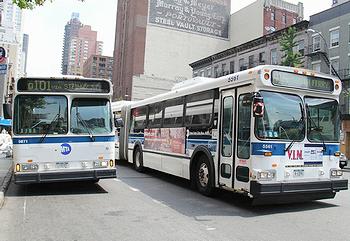
PARIS, France, July 15, 2013 (ENS) – Energy demand for urban transport is expected to double by 2050, but the latest report from the International Energy Agency sees potential savings of up to US$70 trillion through energy efficiency.
“Energy efficiency is what we have termed the hidden fuel, and it is a key component in our efforts to achieve energy security, energy affordability, and environmental sustainability,” said Maria van der Hoeven, executive director of the International Energy Agency. The 28-member, Paris-based organization works within the OECD framework.

Policies that boost the energy efficiency of urban transport systems could help save as much as US$70 trillion in spending on vehicles, fuel and transportation infrastructure between now and 2050, said van der Hoeven Wednesday, introducing the findings of the latest IEA research report.
The report, “A Tale of Renewed Cities,” presents examples from 30 cities to show how transport efficiency can be improved through better urban planning and travel demand management. Extra benefits include lower greenhouse gas emissions and higher quality of life.
The report comes at a critical time. More than half of the world’s population, about 3.5 billion people, now lives in cities.
Rising wealth and increasing vehicle ownership in urban areas has led to shifts away from more fuel-efficient modes, such as public transport and cycling. In some cities, the share of private motorized transport increased by more than 20 percent over the past 20 years, and it is still rising in most developing regions.
Transport currently accounts for half of global oil consumption and nearly 20 percent of world energy use, of which roughly 40 percent is used in urban transport.
Most cities endure traffic jams and overcrowded roads that cost hundreds of billions of dollars in lost fuel and time and harm environmental quality, health and safety.
“As the share of the world’s population living in cities grows to nearly 70 percent by 2050 and energy consumption for transport in cities is expected to double, the need for efficient, affordable, safe and high-capacity transport solutions will become more acute,” said van der Hoeven.

The world has reached a turning point, van der Hoeven said. “The 20th century changed how we move with rapid transit and motorized transport. The 21st century now must address how to move people and goods throughout cities most efficiently.”
“Urgent steps to improve the efficiency of urban transport systems are needed not only for energy security reasons, but also to mitigate the numerous negative climate, noise, air pollution, congestion and economic impacts of rising urban transport volumes,” she said.
Van der Hoeven urged policy makers to take a systems perspective and a long-term view. The report recommends three broad categories of policies – those that allow travel to be avoided, those that shift travel to more efficient modes, and those that improve the efficiency of vehicle and fuel technologies.
“Governments must think beyond individual technologies and electoral cycles, and consider how to build – and how to renew – cities that will accommodate and transport nearly 6.3 billion people by 2050,” van der Hoeven said. “We must plan infrastructure, logistics and energy systems now that make sense today and over the coming decades.”
If fully implemented across the transportation sector, this “avoid, shift and improve” approach could save up to US$70 trillion in lower spending on oil, roadway infrastructure and vehicles, the IEA researchers calculate.
“Avoid” policies address transport energy use and emissions by slowing travel growth through city planning and travel demand management. These “avoid” policies include virtual mobility programs such as tele-working to keep travelers off the roads and use of logistics technology.

“Shift” policies enable and encourage changes from motorized travel to more energy efficient modes, such as public transit, walking, cycling and freight rail.
When motorized travel is necessary, “improve” policies can reduce energy consumption and emissions through the introduction of efficient fuels and vehicles. “Improve” policies include tightened fuel-economy standards and increased advanced-vehicle technology sales, such as clean diesel trucks and hybrid and plug-in electric cars.
The report offers three case studies – Belgrade, Seoul and New York City – to show how those cities have improved their transport systems. It notes, for example, that within the first six months of refurbishing its urban rail system, Belgrade tripled passenger levels.
When Seoul pushed through reforms that no longer rewarded bus operators for carrying more people, ridership, speed and safety all increased.
And New York City shaved 11 minutes off travel times within a year of introducing express bus services, while at the same time attracting more passengers.
“A Tale of Renewed Cities,” which was financially supported by the European Bank for Reconstruction and Development, sets forth a pathway outlining the essential steps and milestones for policy development and implementation to improve urban transport systems.
The pathway is divided into four sections that present planning and actions for supporting development, financing, implementation and evaluation of policies to improve the energy efficiency of urban transport systems. The pathway also provides a list of policy references and practitioner’s guides that are noted throughout the report and on the IEA Policy Pathway Series webpage.
Copyright Environment News Service (ENS) 2013. All rights reserved.
© 2013, Environment News Service. All rights reserved. Content may be quoted only with proper attribution and a direct link to the original article. Full reproduction is prohibited.
